Effect of Cold Drawing and Annealing in Thermomechanical Treatment Route on the Microstructure and Functional Properties of Superelastic Ti-Zr-Nb Alloy
Abstract
:1. Introduction
2. Methodology
2.1. Investigated Alloy and Its Processing
- 600 °C, 5 min (small grain size of ≈3 µm);
- 600 °C, 120 min (intermediate grain size of ≈11 µm);
- 750 °C, 30 min (large grain size of ≈31 µm).
2.2. Experimental Procedure
3. Results and Discussion
3.1. Structure–Phase State
3.2. Mechanical Properties
3.3. Functional Properties
3.4. General Discussion
4. Conclusions
- Cold drawing of the Ti-18-Zr-15Nb alloy promotes elongated grain direction, with a size of 4 × 2 µm in a fine-grained state and a size of 16 × 6 µm in a coarse-grained state. Subsequent annealing at 550 °C for 30 min leads to grain sizes of 5 µm and 3 µm in these states, respectively. Annealing after drawing in the fine-grained state leads to a larger grain size due to the faster recrystallization process in the initially finer-grained structure;
- The texture with a maximum intensity in <102>β parallel to the drawing direction obtained after annealing in fine-grained and coarse-grained states is about the same strength, and the theoretical limit of the recovery strain can be estimated as ~4.3–5%;
- The alloy in a fine-grained state after cold drawing and subsequent post-deformation annealing at 550 °C for 30 min exhibits an excellent combination of the static functional and mechanical properties: relatively high strength (UTS = 624 MPa), sufficient ductility (δ ≈ 8%), the highest difference between the dislocation and transformation yield stress, and high superelastic recovery strain (εrsemax = 3.3%);
- Additional low-temperature aging at 300 °C for 30–180 min leads to the formation of the ω-phase, alloy hardening, a decrease in elongation, and a significant decrease in superelastic recovery strain;
- The obtained results can be used for the further development of new technologies for manufacturing Ti-Zr-Nb thin wires with an enhanced set of functional properties that provide a high level of biological and biomechanical compatibility with bone tissue.
Author Contributions
Funding
Institutional Review Board Statement
Informed Consent Statement
Data Availability Statement
Conflicts of Interest
References
- Miyazaki, S.; Kim, H.Y.; Hosoda, H. Development and characterization of Ni-free Ti-base shape memory and superelastic alloys. Mater. Sci. Eng. A 2006, 438–440, 18–24. [Google Scholar] [CrossRef]
- Héraud, L.; Castany, P.; Ijaz, M.F.; Gordin, D.M.; Gloriant, T. Large-strain functional fatigue properties of superelastic metastable β titanium and NiTi alloys: A comparative study. J. Alloys Compd. 2023, 953, 170170. [Google Scholar] [CrossRef]
- Geetha, M.; Singh, A.K.; Asokamani, R.; Gogia, A.K. Ti Based Biomaterials, the Ultimate Choice for Orthopaedic Implants—A Review. Prog. Mater. Sci. 2009, 54, 397–425. [Google Scholar] [CrossRef]
- Weng, W.; Biesiekierski, A.; Li, Y.; Wen, C. Effects of selected metallic and interstitial elements on the microstructureand mechanical properties of beta titanium alloys for orthopedic applications. Materialia 2019, 6, 100323. [Google Scholar] [CrossRef]
- Marczewski, M.; Miklaszewski, A.; Maeder, X.; Jurczyk, M. Crystal structure evolution, microstructure formation, and properties of mechanically alloyed ultrafine-grained Ti-Zr-Nb Alloys at 36 ≤ Ti ≤ 70 (at.%). Materials 2020, 13, 587. [Google Scholar] [CrossRef] [Green Version]
- Laheurte, P.; Prima, F.; Eberhardt, A.; Gloriant, T.; Wary, M.; Patoor, E. Mechanical properties of low modulus β titanium alloys designed from the electronic approach. J. Mech. Behav. Biomed. Mater. 2010, 3, 565–573. [Google Scholar] [CrossRef]
- Sheremetyev, V.; Dubinskiy, S.; Kudryashova, A.; Prokoshkin, S.; Brailovski, V. In Situ XRD Study of Stress- and Cooling-Induced Martensitic Transformations in Ultrafine- and Nano-Grained Superelastic Ti-18Zr-14Nb Alloy. J. Alloys Compd. 2022, 902, 163704. [Google Scholar] [CrossRef]
- Kim, H.Y.; Fu, J.; Tobe, H.; Kim, J.I.; Miyazaki, S. Crystal Structure, Transformation Strain, and Superelastic Property of Ti–Nb–Zr and Ti–Nb–Ta Alloys. Shape Mem. Superelast. 2015, 1, 107–116. [Google Scholar] [CrossRef] [Green Version]
- Jabir, H.; Fillon, A.; Castany, P.; Gloriant, T. Crystallographic Orientation Dependence of Mechanical Properties in the Superelastic Ti-24Nb-4Zr-8Sn Alloy. Phys. Rev. Mater. 2019, 3, 063608. [Google Scholar] [CrossRef]
- Vieira Nunes, A.R.; Borborema, S.; Araújo, L.S.; Malet, L.; Dille, J.; Henrique de Almeida, L. Influence of thermo-mechanical processing on structure and mechanical properties of a new metastable β Ti-29Nb-2Mo-6Zr alloy with low Young’s modulus. J. Alloys Compd. 2020, 820, 153078. [Google Scholar] [CrossRef]
- Konopatsky, A.; Sheremetyev, V.; Dubinskiy, S.; Zhukova, Y.; Firestein, K.; Golberg, D.; Filonov, M.; Prokoshkin, S.; Brailovski, V. Structure and Superelasticity of Novel Zr-Rich Ti-Zr-Nb Shape Memory Alloys. Shape Mem. Superelast. 2021, 7, 304–313. [Google Scholar] [CrossRef]
- Sheremetyev, V.; Lukashevich, K.; Kreitcberg, A.; Kudryashova, A.; Tsaturyants, M.; Galkin, S.; Andreev, V.; Prokoshkin, S.; Brailovski, V. Optimization of a Thermomechanical Treatment of Superelastic Ti-Zr-Nb Alloys for the Production of Bar Stock for Orthopedic Implants. J. Alloys Compd. 2022, 928, 167143. [Google Scholar] [CrossRef]
- Cojocaru, V.D.; Raducanu, D.; Gloriant, T.; Gordin, D.M.; Cinca, I. Effects of cold-rolling deformation on texture evolution and mechanical properties of Ti–29Nb–9Ta–10Zr alloy. Mater. Sci. Eng. A 2013, 586, 1–10. [Google Scholar] [CrossRef] [Green Version]
- Fu, J.; Yamamoto, A.; Kim, H.Y.; Hosoda, H.; Miyazaki, S. Novel Ti-Base Superelastic Alloys with Large Recovery Strain and Excellent Biocompatibility. Acta Biomater. 2015, 17, 56–67. [Google Scholar] [CrossRef]
- Pavon, L.L.; Cuellar, E.L.; Hernandez, S.V.; Moreno-Cortez, I.E.; Kim, H.Y.; Miyazaki, S. Effect of heat treatment condition on microstructure and superelastic properties of Ti24Zr10Nb2Sn. J. Alloys Compd. 2019, 782, 893–898. [Google Scholar] [CrossRef]
- Fu, J.; Kim, H.Y.; Miyazaki, S. Effect of annealing temperature on microstructure and superelastic properties of a Ti-18Zr-4.5Nb-3Sn-2Mo alloy. J. Mech. Behav. Biomed. Mater. 2017, 65, 716–723. [Google Scholar] [CrossRef]
- Lukashevich, K.; Sheremetyev, V.; Komissarov, A.; Cheverikin, V.; Andreev, V.; Prokoshkin, S.; Brailovski, V. Effect of Cooling and Annealing Conditions on the Microstructure, Mechanical and Superelastic Behavior of a Rotary Forged Ti–18Zr–15Nb (at. %) Bar Stock for Spinal Implants. J. Funct. Biomater. 2022, 13, 259. [Google Scholar] [CrossRef]
- Tsuchiya, K.; Hada, Y.; Koyano, T.; Nakajima, K.; Ohnuma, M.; Koike, T.; Todaka, Y.; Umemotob, M. Production of TiNi amorphous/nanocrystalline wires with high strength and elastic modulus by severe cold drawing. Scr. Mater. 2009, 60, 749–752. [Google Scholar] [CrossRef]
- Balasubramanian, R.; Nagumothu, R.; Parfenov, E.; Valiev, R. Development of nanostructured titanium implants for biomedical implants—A short review. Mater. Today Proc. 2021, 46, 1195–1200. [Google Scholar] [CrossRef]
- Valiev, R.Z.; Sabirov, I.; Zemtsova, E.G.; Parfenov, E.V.; Dluhos, L.; Lowe, T.C. Nanostructured commercially pure titanium for development of miniaturized biomedical implants. In Titanium in Medical and Dental Applications; Woodhead Publishing Series in Biomaterials; Woodhead Publishing: Sawston, UK, 2018; pp. 393–417. [Google Scholar] [CrossRef]
- Perlin, I.L.; Ermanok, M.Z. Drawing Theory; Metallurgy: Moscow, Russia, 1971; p. 448. [Google Scholar]
- Hayak, G.S. Wire Drawing from Non-Ferrous Metals and Alloys; Metallurgy: Moscow, Russia, 1967; p. 151. [Google Scholar]
- Kusta, P.; Wrobel, M.; Byrska-Wojcik, D.; Packo, M.; Plonka, B.; Wrobel, M.; Sulej-Chojnacka, J.; Milenin, A. Manufacture technology, mechanical and biocorrosion properties of the Zn and ZnMg0.008 alloy wires designed for biodegradable surgical threads. J. Manuf. Process. 2021, 67, 513–520. [Google Scholar] [CrossRef]
- Gao, Z.; Zhang, X.; Huang, H.; Chen, C.; Jiang, J.; Niu, J.; Dargusch, M.; Yuan, G. Microstructure evolution, mechanical properties and corrosion behavior of biodegradable Zn-2Cu-0. 8Li alloy during room temperature drawing. Mater. Charact. 2022, 185, 111722. [Google Scholar] [CrossRef]
- Gao, M.; Yang, K.; Tan, L.; Ma, Z. Improvement of mechanical property and corrosion resistance of Mg-Zn-Nd alloy by bi-direction drawing. J. Mater. Sci. Technol. 2021, 81, 88–96. [Google Scholar] [CrossRef]
- Do, H.; Kim, Y.; Mawardi, F.; Listyawan, T.A.; Baek, E.R.; Park, N. The effect of cold drawing process on the microstructure evolution of Ti-4.5Al-2.5Fe-0.15O titanium alloy. Mater. Lett. 2021, 286, 129219. [Google Scholar] [CrossRef]
- Zeng, L.; Bieler, T.R. Effects of working, heat treatment, and aging on microstructural evolution and crystallographic texture of α, α’, α″ and β phases in Ti–6Al–4V wire. Mater. Sci. Eng. A 2005, 392, 403–414. [Google Scholar] [CrossRef]
- Antunes, A.D.S.; Santos, O.D.S.; Naito, L.K.F.; Rigo, O.D.; Otubo, J. The wire drawing mechanics of near-equiatomic NiTi SMA. Mater. Res. 2018, 21, e20170944. [Google Scholar] [CrossRef]
- Chaudhari, R.; Vora, J.J.; Parikh, D.M. A review on applications of nitinol shape memory alloy. In Recent Advances in Mechanical Infrastructure: Proceedings of ICRAM 2020, Ahmedabad, India, 21–23 August 2020; Springer: Singapore, 2021; pp. 123–132. [Google Scholar] [CrossRef]
- Imai, T.; Watari, F.; Yamagata, S.; Kobayashi, M.; Nagayama, K.; Toyoizumi, Y.; Nakamura, S. Mechanical properties and aesthetics of FRP orthodontic wire fabricated by hot drawing. Biomaterials 1998, 19, 2195–2200. [Google Scholar] [CrossRef]
- Hu, M.; Dong, L.; Zhang, Z.; Lei, X.; Yang, R.; Sha, Y. Effects of multi-pass drawing strain and heat treatment on microstructure, texture and mechanical properties of Ti-6Al-4V alloy. Mater. Sci. Eng. A 2019, 757, 70–83. [Google Scholar] [CrossRef]
- Ryklina, E.; Polyakova, K.; Prokoshkin, S. Comparative study of shape memory effects in Ni-rich Ti-Ni alloy after training in various phase states. Shape Mem. Superelast. 2020, 6, 157–169. [Google Scholar] [CrossRef]
- Ryklina, E.P.; Polyakova, K.A.; Murygin, S.R.; Isaenkova, M.G.; Zaripova, M.M.; Fesenko, V.A.; Komarov, V.S.; Andreev, N.V.; Resnina, N.N.; Andreev, V.A. On Textural Heredity of Ni-rich Ti–Ni alloy: Specific Features of Transformation and Tensile Behavior. Shape Mem. Superelast. 2023. [Google Scholar] [CrossRef]
- Guillem-Marti, J.; Herranz-Diez, C.; Shaffer, J.E.; Gil, F.J.; Manero, J.M. Mechanical and microstructural characterization of new nickel-free low modulus β-type titanium wires during thermomechanical treatments. Mater. Sci. Eng. A 2015, 636, 507–515. [Google Scholar] [CrossRef] [Green Version]
- Niinomi, M.; Akahori, T.; Katsura, S.; Yamauchi, K.; Ogawa, M. Mechanical Characteristics and Microstructure of Drawn Wire of Ti-29Nb-13Ta-4.6Zr for Biomedical Applications. Mater. Sci. Eng. C 2007, 27, 154–161. [Google Scholar] [CrossRef]
- Niinomi, M. Improvement in mechanical performance of low-modulus β-Ti-Nb-Ta-Zr system alloys by microstructural control via thermomechanical processing. Int. J. Mod. Phys. B 2008, 22, 2787–2795. [Google Scholar] [CrossRef]
- Guo, S.; Ding, W.; Zhang, H.; Lu, W.; Liu, G.; Liu, H.; Cheng, X.; Zhao, X. Mechanisms of near-linear elastic deformation behavior in a binary metastable β-type Ti-Nb alloy with large recoverable strain. Mater Charact 2022, 187, 111858. [Google Scholar] [CrossRef]
- Hickman, B.S. The formation of omega phase in titanium and zirconium alloys: A review. J. Mater. Sci. 1969, 4, 554–563. [Google Scholar] [CrossRef]
- Wang, K.; Wu, D.; Wang, D.; Deng, Z.; Tian, Y.; Zhang, L.; Liu, L. Influence of cooling rate on ω phase precipitation and deformation mechanism of a novel metastable β titanium alloy. Mater. Sci. Eng. A 2022, 829, 142151. [Google Scholar] [CrossRef]
- Zaimovsky, V.A.; Polyak, E.I.; Faldin, S.A.; Bernstein, M.L. The Structure and Properties of Metals and Alloys; Laboratory Workshop; Printing Office of the Moscow Institute of Steel and Alloys: Moscow, Russia, 1988; p. 91. [Google Scholar]
- Rollett, A.; Humphreys, F.; Rohrer, G.S.; Hatherly, M. Recrystallization and Related Annealing Phenomena, 2nd ed.; Elsevier: Amsterdam, The Netherlands, 2004; p. 628. [Google Scholar]
- Li, Q.; Niinomi, M.; Nakai, M.; Cui, Z.; Zhua, S.; Yanga, X. Effect of Zr on super-elasticity and mechanical properties of Ti–24 at% Nb–(0, 2, 4) at% Zr alloy subjected to aging treatment. Mater. Sci. Eng. A 2012, 536, 197–206. [Google Scholar] [CrossRef]
- Sheremetyev, V.; Kudryashova, A.; Cheverikin, V.; Korotitskiy, A.; Galkin, S.; Prokoshkin, S.; Brailovski, V. Hot Radial Shear Rolling and Rotary Forging of Metastable Beta Ti-18Zr-14Nb (at. %) Alloy for Bone Implants: Microstructure, Texture and Functional Properties. J. Alloys Compd. 2019, 800, 320–326. [Google Scholar] [CrossRef]


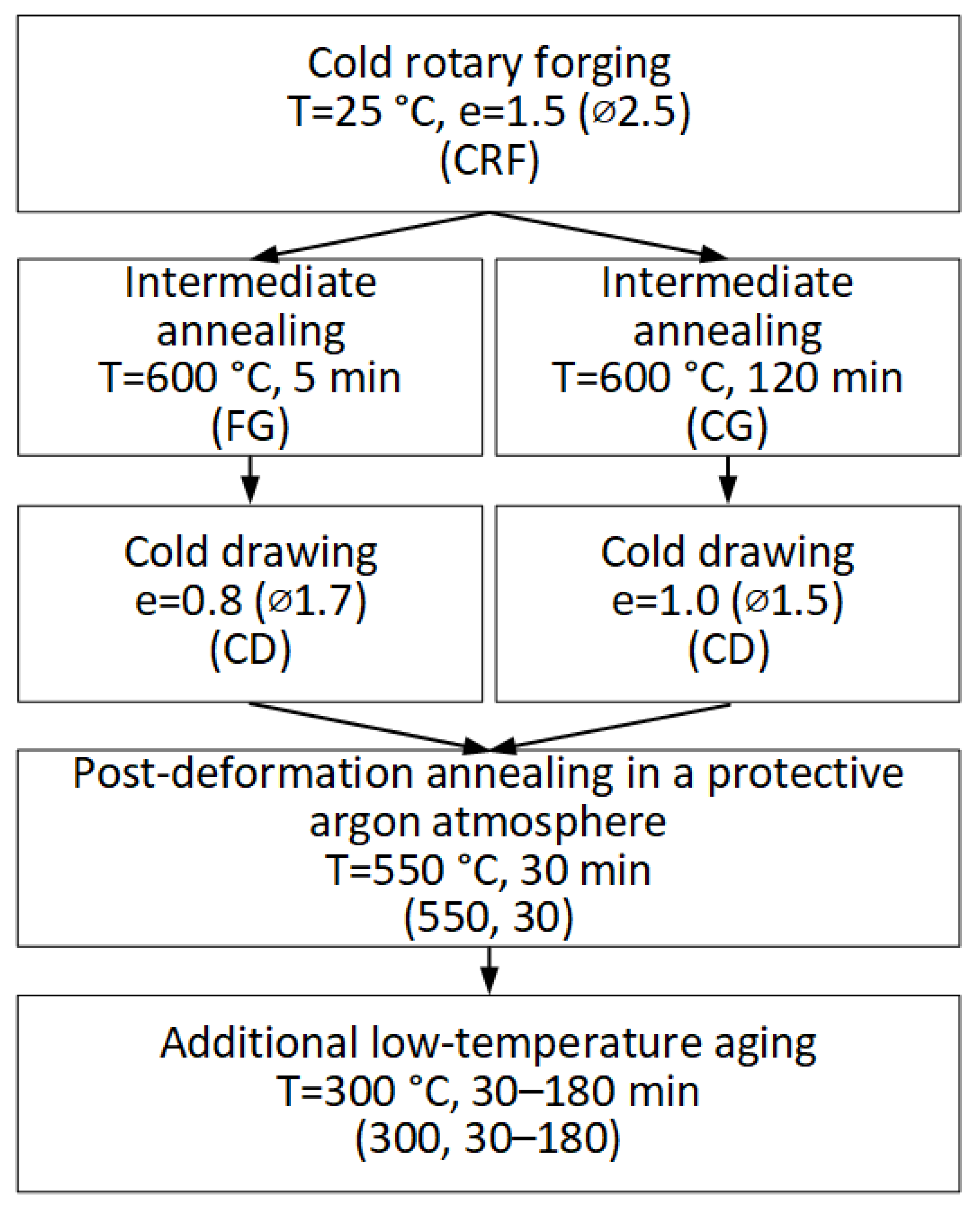
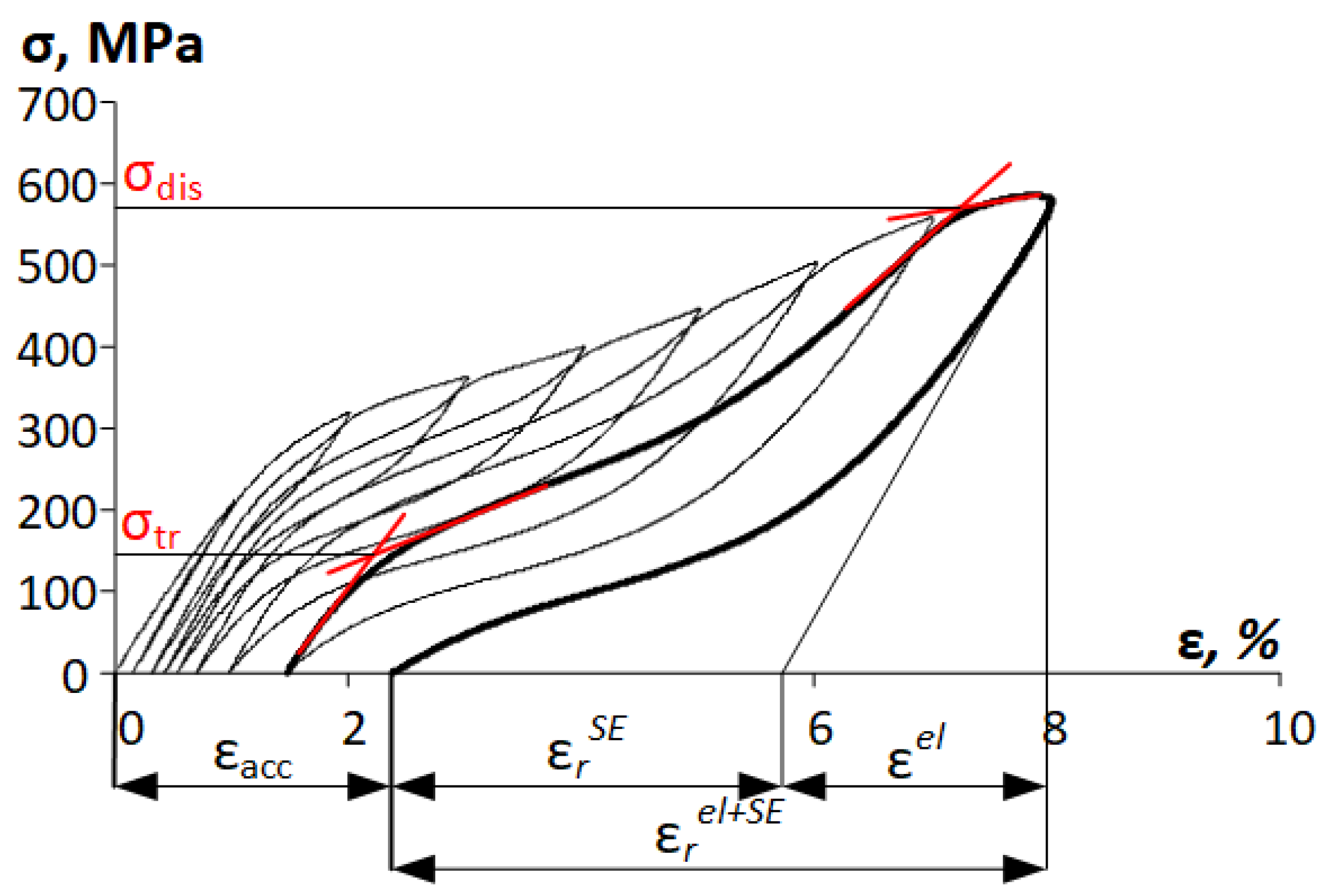
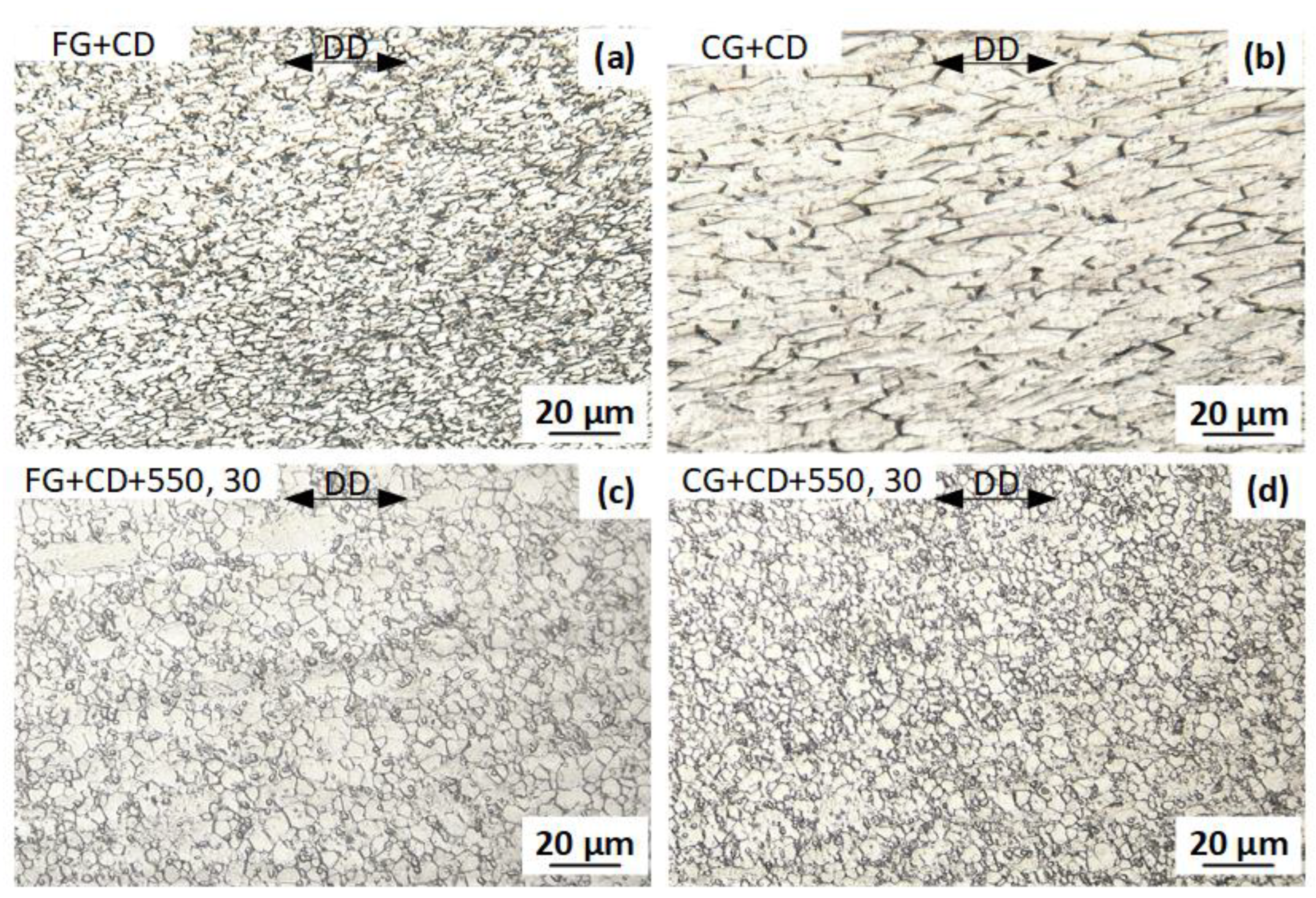
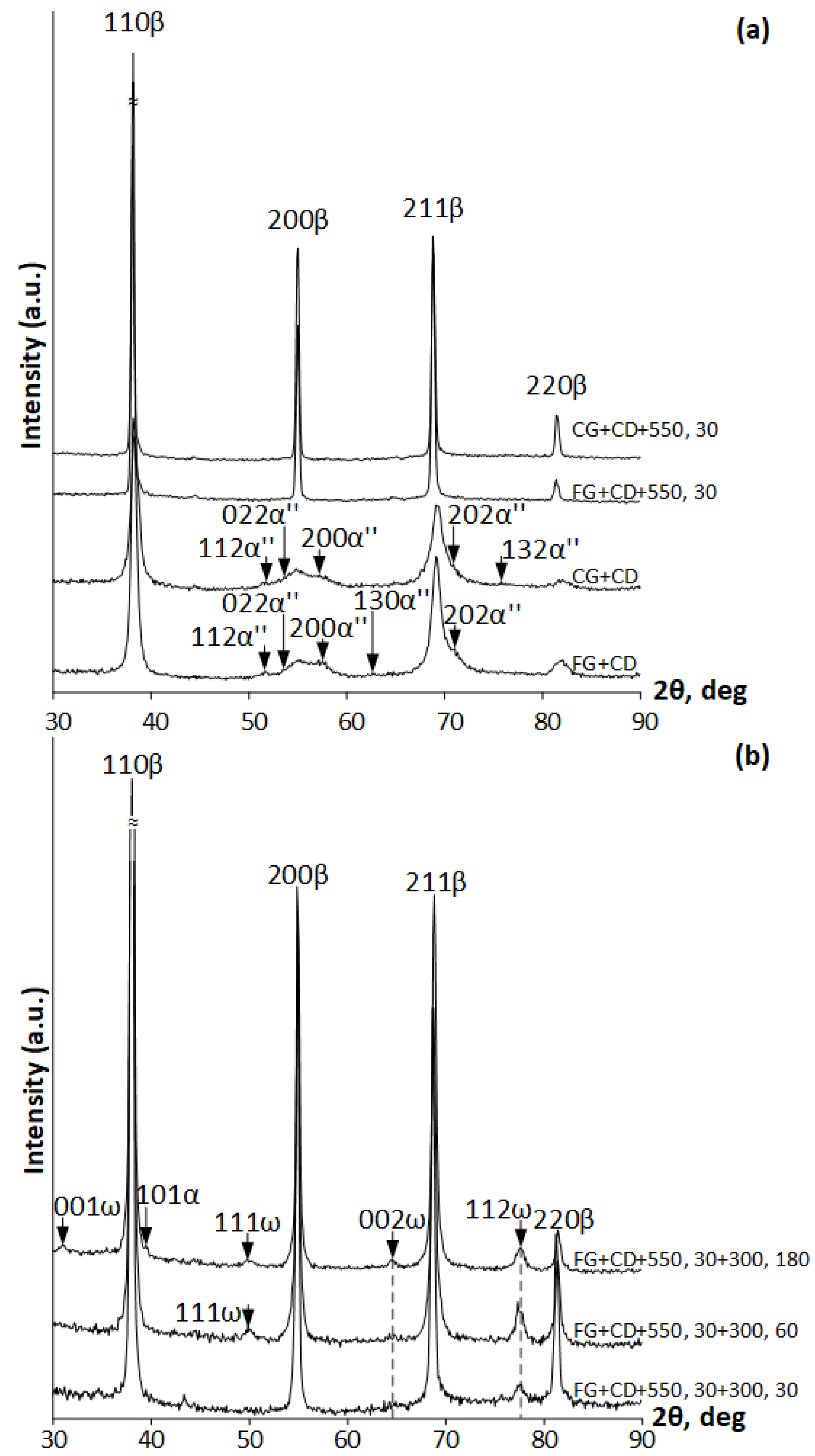
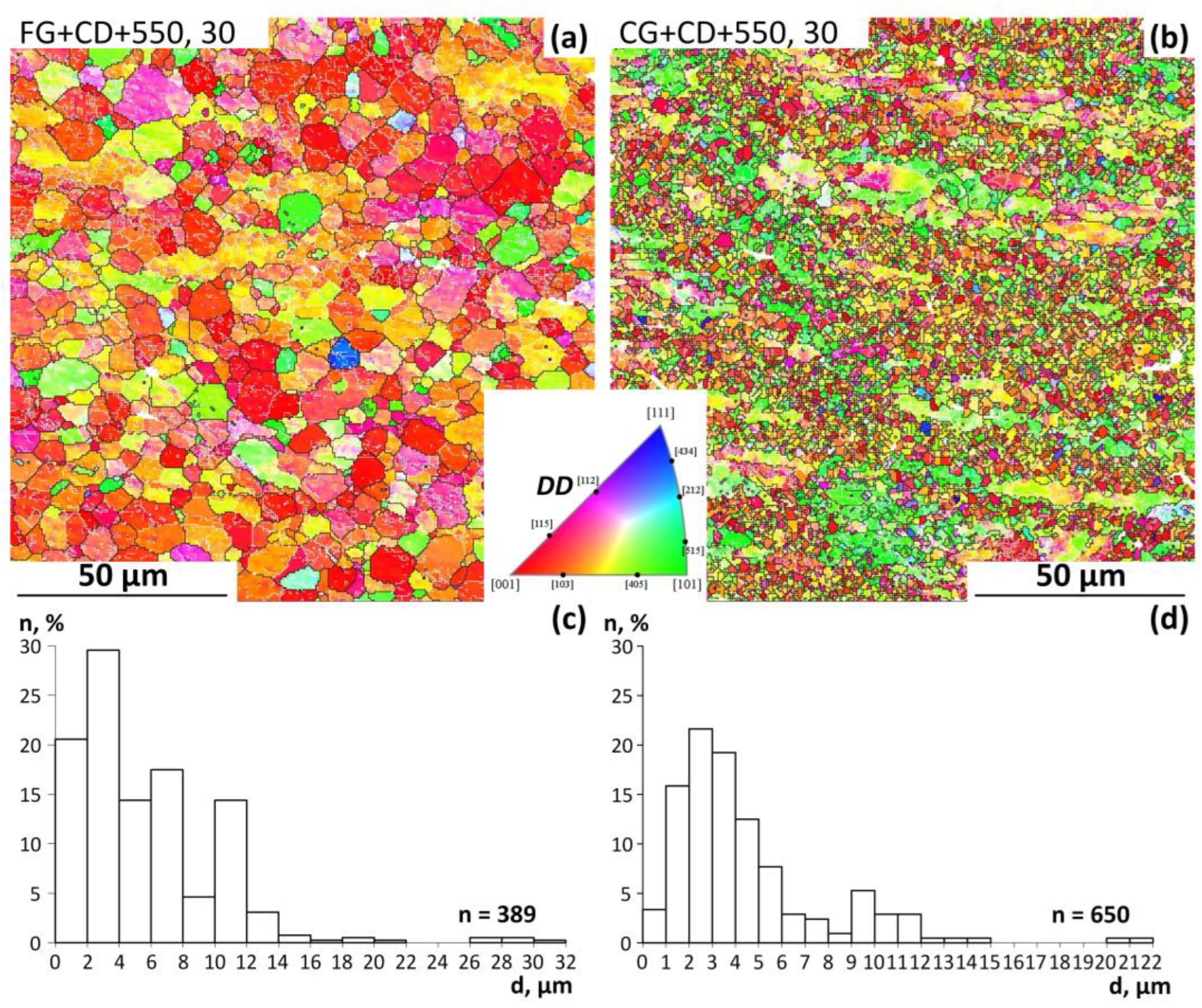

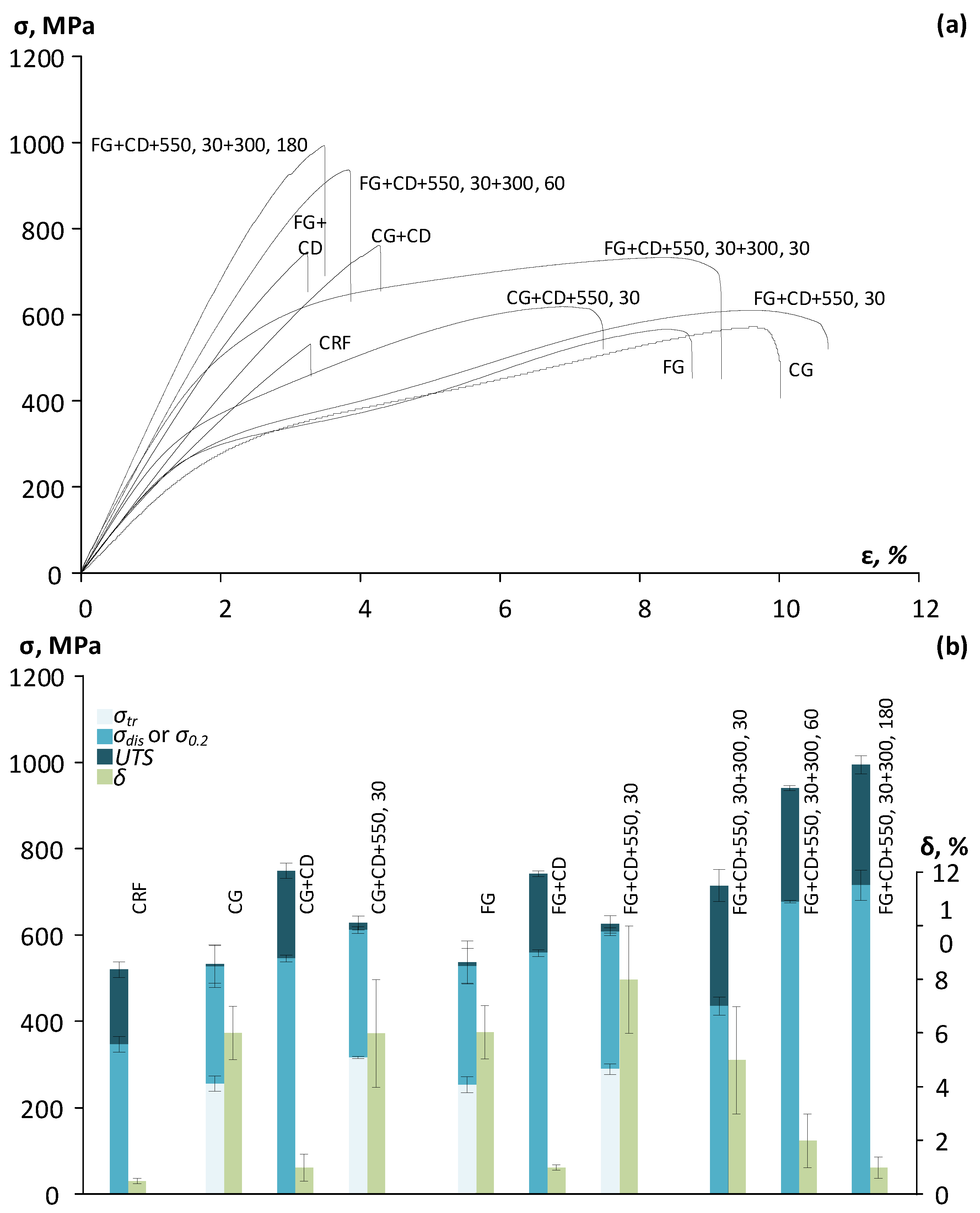
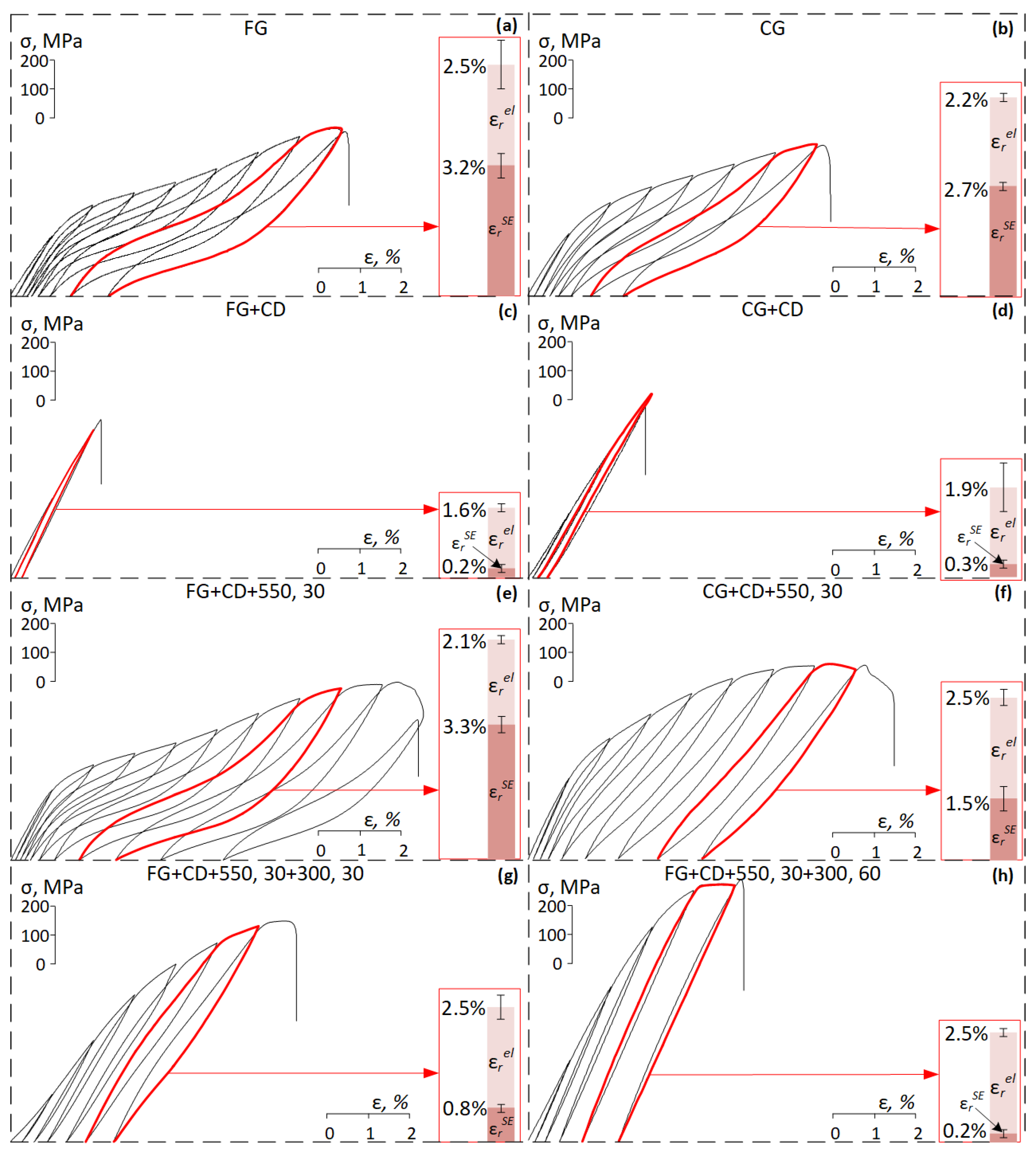
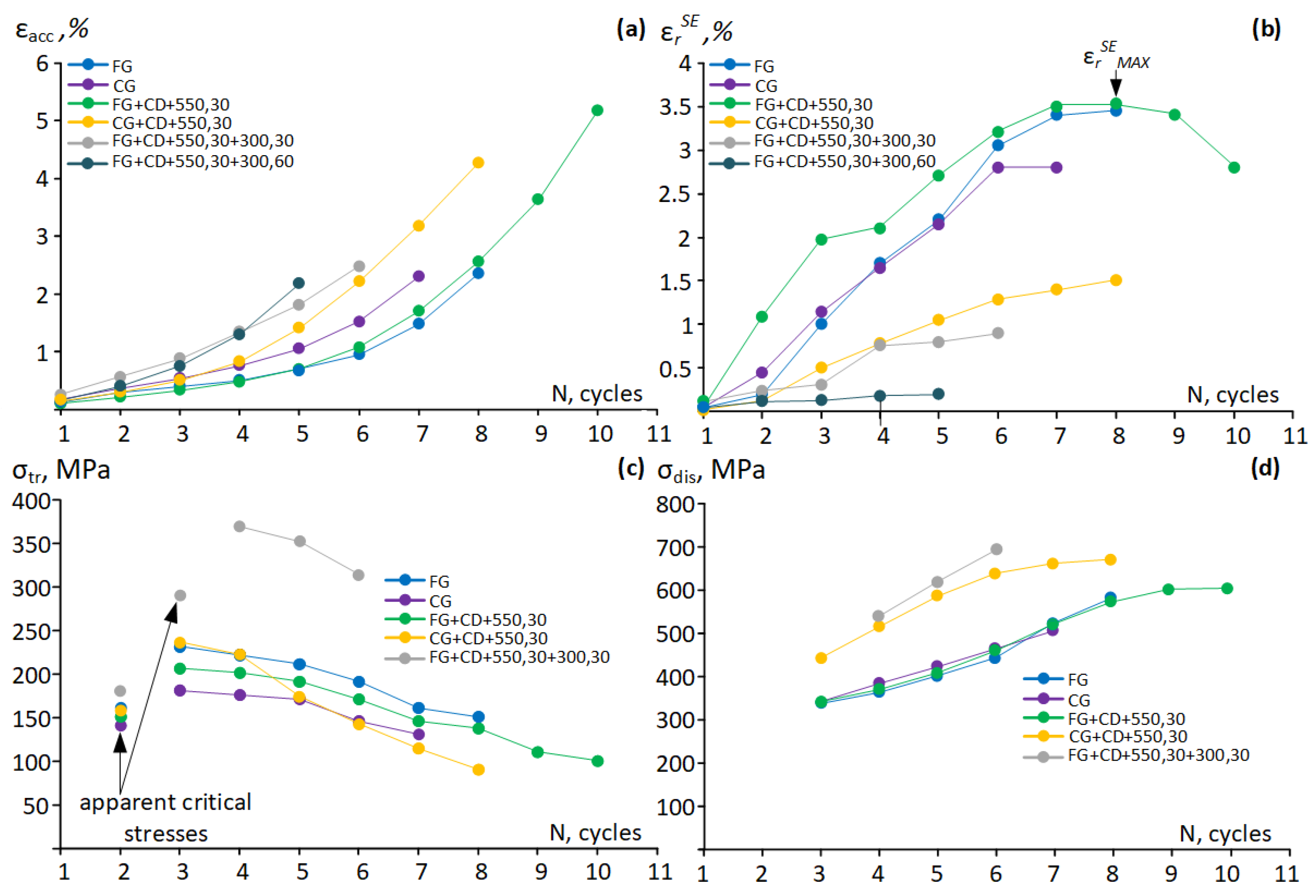

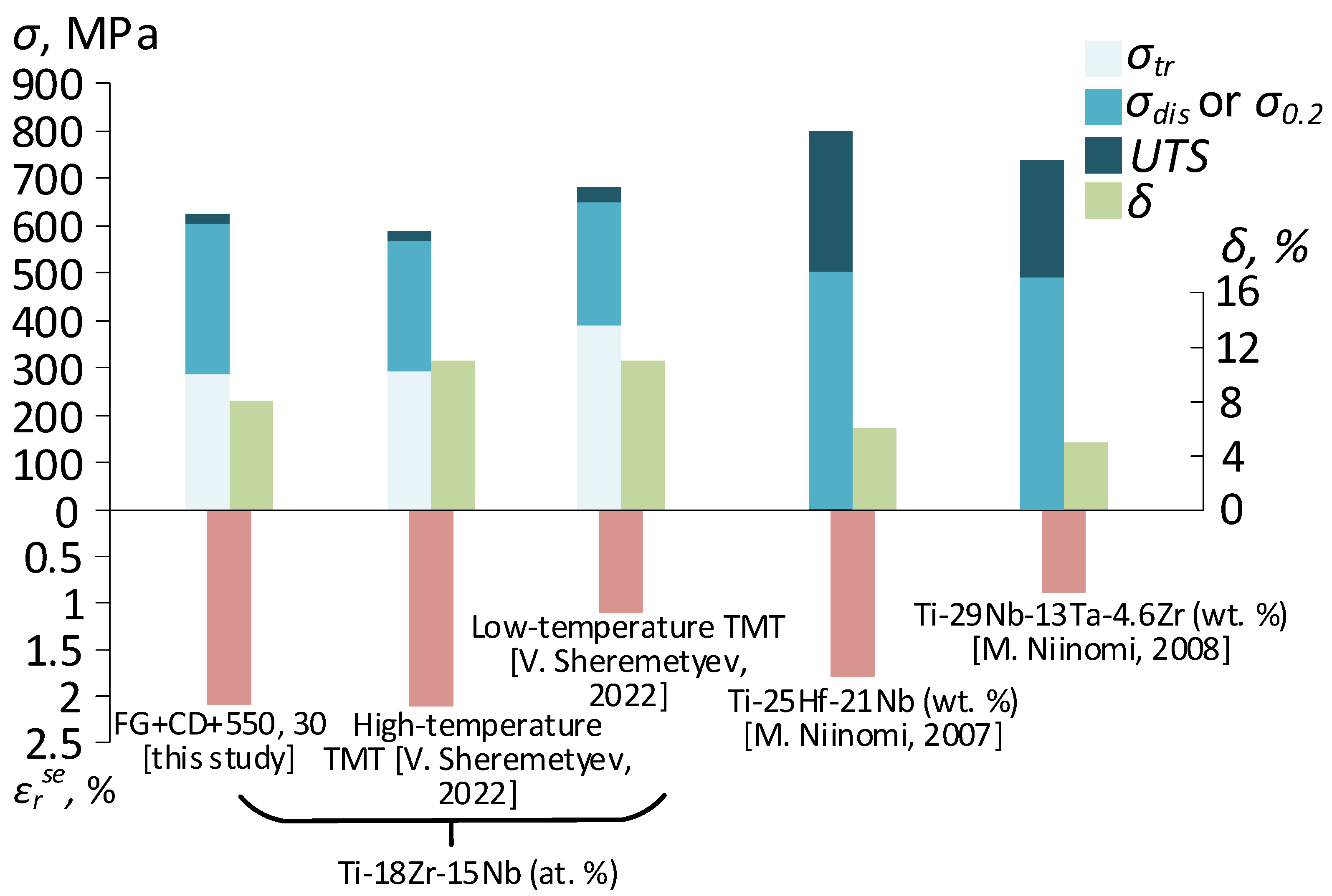
| TMT Route | δ, % | σtr | σdis, MPa | UTS, MPa |
|---|---|---|---|---|
| CRF | 0.5 ± 0.1 | - | 345 ± 17 * | 519 ± 18 |
| CG | 6.0 ± 1.0 | 255 ± 17 | 526 ± 48 | 532 ± 45 |
| CG+CD | 1.0 ± 0.5 | - | 544 ± 8 * | 748 ± 18 |
| CG+CD+550, 30 | 6.0 ± 2.0 | 315 ± 3 | 611 ± 8 | 627 ± 16 |
| FG | 6.0 ± 1.0 | 251 ± 18 | 525 ± 41 | 535 ± 49 |
| FG+CD | 1.0 ± 0.1 | - | 562 ± 9 * | 741 ± 7 |
| FG+CD+550, 30 | 8.0 ± 2.0 | 288 ± 12 | 607 ± 9 | 624 ± 20 |
| FG+CD+550, 30+300, 30 | 5.0 ± 2.0 | - | 434 ± 21 * | 714 ± 37 |
| FG+CD+550, 30+300, 60 | 2.0 ± 1.0 | - | 675 ± 3 * | 940 ± 6 |
| FG+CD+550, 30+300, 180 | 1.0 ± 0.4 | - | 714 ± 35 * | 994 ± 21 |
Disclaimer/Publisher’s Note: The statements, opinions and data contained in all publications are solely those of the individual author(s) and contributor(s) and not of MDPI and/or the editor(s). MDPI and/or the editor(s) disclaim responsibility for any injury to people or property resulting from any ideas, methods, instructions or products referred to in the content. |
© 2023 by the authors. Licensee MDPI, Basel, Switzerland. This article is an open access article distributed under the terms and conditions of the Creative Commons Attribution (CC BY) license (https://creativecommons.org/licenses/by/4.0/).
Share and Cite
Kudryashova, A.; Lukashevich, K.; Derkach, M.; Strakhov, O.; Dubinskiy, S.; Andreev, V.; Prokoshkin, S.; Sheremetyev, V. Effect of Cold Drawing and Annealing in Thermomechanical Treatment Route on the Microstructure and Functional Properties of Superelastic Ti-Zr-Nb Alloy. Materials 2023, 16, 5017. https://doi.org/10.3390/ma16145017
Kudryashova A, Lukashevich K, Derkach M, Strakhov O, Dubinskiy S, Andreev V, Prokoshkin S, Sheremetyev V. Effect of Cold Drawing and Annealing in Thermomechanical Treatment Route on the Microstructure and Functional Properties of Superelastic Ti-Zr-Nb Alloy. Materials. 2023; 16(14):5017. https://doi.org/10.3390/ma16145017
Chicago/Turabian StyleKudryashova, Anastasia, Konstantin Lukashevich, Mikhail Derkach, Oleg Strakhov, Sergey Dubinskiy, Vladimir Andreev, Sergey Prokoshkin, and Vadim Sheremetyev. 2023. "Effect of Cold Drawing and Annealing in Thermomechanical Treatment Route on the Microstructure and Functional Properties of Superelastic Ti-Zr-Nb Alloy" Materials 16, no. 14: 5017. https://doi.org/10.3390/ma16145017






